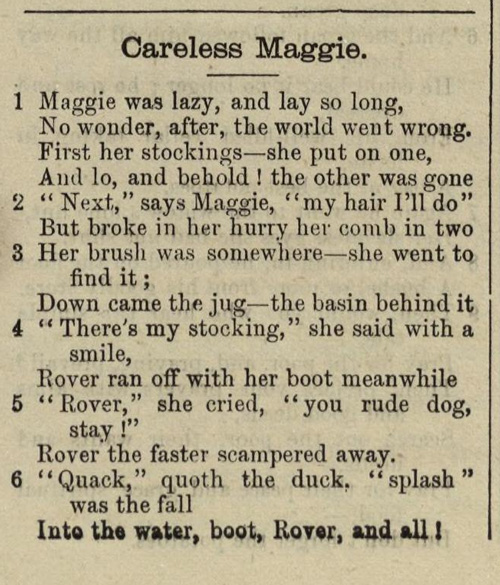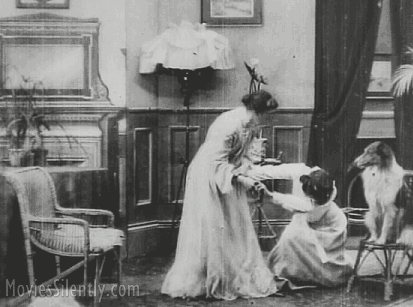When a baby is kidnapped, it’s up to the family dog to save the day! An early entry in the Heroic Dog genre of motion pictures, this British production has charm to spare.
He can’t hold his licker
Cecil Hepworth is one of the more important names in early British cinema and his works include the wicked trick film How it Feels to be Run Over (1900) and a comparatively lavish 1903 adaptation of Alice in Wonderland. However, his reputation mostly rests on an inexpensive production based on a story written by his wife and starring his dog and his infant daughter. Let’s see what Hepworth made on a budget of seven pounds thirteen shillings and sixpence.

The story is simple: a nurse snubs a beggar woman dressed in a tattered afghan. The beggar vows revenge and takes it by stealing the nurse’s charge, a baby. When the nurse runs home to tell the baby’s parents (Cecil and Margaret Hepworth), the family dog springs into action. He tracks down the baby, gets the attention of the child’s father (“I think he’s trying to tell us something!”) and leads him to the hovel where the beggar is hiding out. The little family is reunited as the dog looks on happily.

In his memoirs, Cecil Hepworth writes about the film with endearing modesty: “Why in the world I should have thought it necessary to play the part throughout in a frock coat and tall hat is more than I can understand.” Still, he obviously had great affection for the picture, which would prove to be one of his most popular projects.
Rescued by Rover was the runaway hit of 1905 and Hepworth was famously obliged to remake it twice because he wore out two negatives. He claimed that the film ended up with 400 prints in circulation, which would have been a mammoth blockbuster for the time. Edison’s biggest hit of 1906, Dream of a Rarebit Fiend, sold just shy of 200 prints and most films from the company averaged between 50 and 140 prints.

This film has a lot of “firsts” attached to it that, frankly, I find dubious. First narrative film to use a dog? Pretty hard to prove considering how many lost films there are. First to use paid actors? Ditto. Many early studio records no longer exist, if they ever existed, so how can we possibly prove which performers were the first to draw a salary? I believe that this notion may come from a misreading of Hepworth’s memoirs, as he states that Rescued by Rover was the first film in which he employed professional actors. However, he is very clear that he is only speaking for himself and not the film industry as a whole. (Poor reading comprehension can be blamed for all manner of movie myths, including the infamous “Cecil B. DeMille caused a man to be shot” tale.)

Wikipedia also confidently claims that this film popularized Rover, an “uncommon” dog name. Perhaps proponents of this theory would care to explain why Rover is listed as a common dog name as far back as 1718. No takers? Didn’t think so. (You can read a pretty decent breakdown of the history of Rover here. Needless to say, Wikipedia is full of hot air.)


What no one disputes is that this film has smooth editing and a strong narrative drive. As the grammar of cinema was still being developed, some early films could be confusing or slow. Rescued by Rover neatly slices down the search and rescue, showing the most important bits and generally not wasting time with information the audience already knows. A few shots are a bit longer than they need to be but the film is generally quite modern in its narrative choices.

So, we can talk about the film’s slick editing and the appeal of its straightforward plot but I’m going to be honest here, the reason this film was a hit and the reason for its continued appeal can be summed up in one word: Blair.
Blair was the Hepworth family dog, which only adds to the charming homespun quality of the picture. Blair was also charismatic, photogenic and an awful little ham. In other words, the ideal early movie star.

Blair’s appeal is similar to that of Hal Roach’s Our Gang series. The children were hired to act like kids, not the over-rehearsed automatons child performers who were swarming over American films. While I enjoy seeing a well-trained dog in action, there is something enchanting about Blair’s unrehearsed moments. He’s just so happy to be there and so happy to be with his family and friends and so happy to be making new friends! Darn it, I want to take Blair home!

For example, when the nurse bursts in the tell the mother that the child has been stolen, Blair is sitting on a chair looking at the camera. But as the nurse tells her tale, he decides to help the situation by licking her face. And at the end, when the child is returned home, Blair is beside himself with joy, throwing himself on the baby and her mother. The noble canine is all well and good but Blair would rather give kisses, so there. Perhaps Hepworth’s best creative decision was simply to let Blair be Blair.

Rescued by Rover is important, don’t get me wrong, but it is also first class entertainment that still manages to win over audiences. Its homespun charm and charismatic star assure that it will continue to amuse viewers for another century.
A huge thanks to Christopher Bird for contributing research and for sharing the header image.
Where can I see it?
Rescued by Rover is available on DVD as part of the epic The Movies Begin box set.
***
Like what you’re reading? Please consider sponsoring me on Patreon. All patrons will get early previews of upcoming features, exclusive polls and other goodies.

Huzzah! The British are coming! Sadly, in cinema, we rarely get there. Hepworth also pioneered “song” pictures,did he not?
I have been rather pleasantly surprised with British silents, I must say, though I think the 1890s and 1900s are my favorite decades for it. I do know that Hepworth did work with songs tied into motion pictures but I’m not sure exactly where he falls in the chronology. Fascinating man!
I notice Pluto is on your list of most common dog names of 1718. And I had always thought Walt Disney had gotten his name for Pluto the Dog from the planet Pluto! Pluto is actually a common dog name..
Yes, there are several pretty modern names on that list: Lady, Violet, Caesar.
I enjoyed Hepworth’s memoir immensely, as it has a lot of humor in it (and tragedy too—the film editor that burned up in the studio fire!). I do think he was likely responsible for a lot of BRITISH firsts.
He was definitely a mad innovator! 🙂
Love your colorized still of Blair, with Baby in tow, at the wheel of an ’05 (or earlier) Maudslay! Wonder Dog, indeed!
Such a beautiful and fun vignette of a film. Someone gifted us with The Movies Begin when it first came out- just had to re-watch Hepworth’s little jewel this evening.
Thank you so much! Yes, this is an absolute treasure of a film!
Hepworth’s song pictures were being shown at the Palace in Walsall in mid 1910, if that’s any help.
Gaumont was releasing musical pictures in the mid-1900s but there was quite a bit of parallel inventing going on.